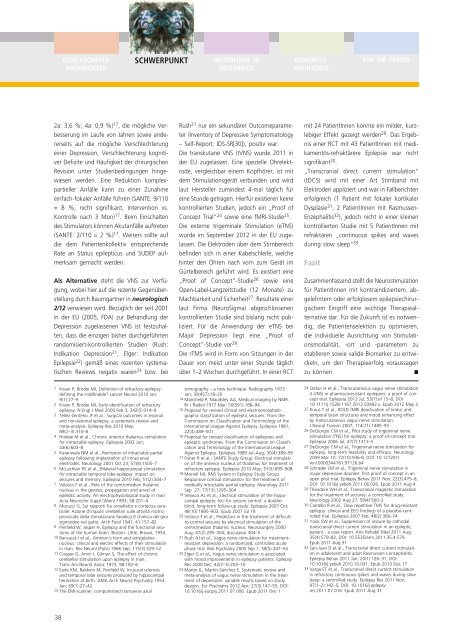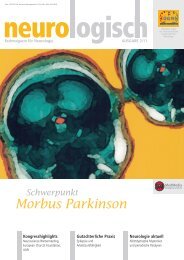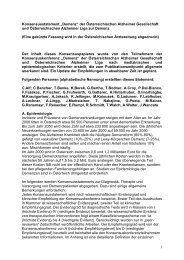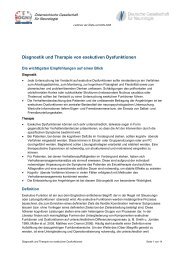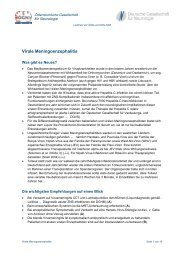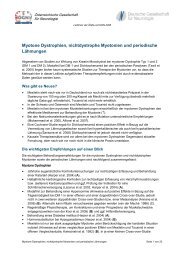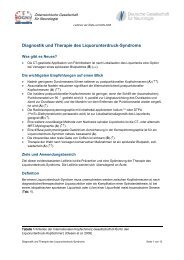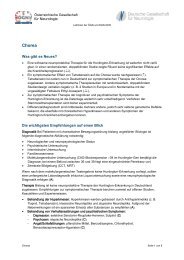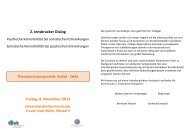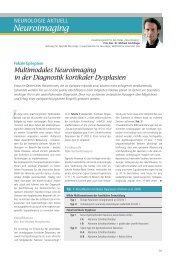Neues aus der Epileptologie - Ãsterreichische Gesellschaft für ...
Neues aus der Epileptologie - Ãsterreichische Gesellschaft für ...
Neues aus der Epileptologie - Ãsterreichische Gesellschaft für ...
Erfolgreiche ePaper selbst erstellen
Machen Sie aus Ihren PDF Publikationen ein blätterbares Flipbook mit unserer einzigartigen Google optimierten e-Paper Software.
GESELLSCHAFTS-<br />
NACHRICHTEN<br />
SCHWERPUNKT<br />
NEUROLOGIE IN<br />
ÖSTERREICH<br />
KONGRESS-<br />
HIGHLIGHTS<br />
FÜR DIE PRAXIS<br />
2a: 3,6 %; 4a: 0,9 %) 17 , die mögliche Verbesserung<br />
im Laufe von Jahren sowie an<strong>der</strong>erseits<br />
auf die mögliche Verschlechterung<br />
einer Depression, Verschlechterung kognitiver<br />
Defizite und Häufigkeit <strong>der</strong> chirurgischen<br />
Revision unter Studienbedingungen hingewiesen<br />
werden. Eine Reduktion komplexpartieller<br />
Anfälle kann zu einer Zunahme<br />
einfach-fokaler Anfälle führen (SANTE: 9/110<br />
= 8 %, nicht signifikant, Intervention vs.<br />
Kontrolle nach 3 Mon) 17 . Beim Einschalten<br />
des Stimulators können Akutanfälle auftreten<br />
(SANTE: 2/110 = 2 %) 17 . Weiters sollte auf<br />
die dem Patientenkollektiv entsprechende<br />
Rate an Status epilepticus und SUDEP aufmerksam<br />
gemacht werden.<br />
Als Alternative steht die VNS zur Verfügung,<br />
wobei hier auf die rezente Gegenüberstellung<br />
durch Baumgartner in neurologisch<br />
2/12 verwiesen wird. Bezüglich <strong>der</strong> seit 2001<br />
in <strong>der</strong> EU (2005, FDA) zur Behandlung <strong>der</strong><br />
Depression zugelassenen VNS ist festzuhalten,<br />
dass die einzigen bisher durchgeführten<br />
randomisiert-kontrollierten Studien (Rush:<br />
Indikation Depression 21 , Elger: Indikation<br />
Epilepsie 22 ) gemäß eines rezenten systematischen<br />
Reviews negativ waren 23 bzw. bei<br />
Rush 21 nur ein sekundärer Outcomeparameter<br />
(Inventory of Depressive Symptomatology<br />
– Self-Report: IDS-SR[30]), positiv war.<br />
Die transkutane VNS (tVNS) wurde 2011 in<br />
<strong>der</strong> EU zugelassen. Eine spezielle Ohrelektrode,<br />
vergleichbar einem Kopfhörer, ist mit<br />
dem Stimulationsgerät verbunden und wird<br />
laut Hersteller zumindest 4-mal täglich für<br />
eine Stunde getragen. Hierfür existieren keine<br />
kontrollierten Studien, jedoch ein „Proof of<br />
Concept Trial“ 24 sowie eine fMRI-Studie 25 .<br />
Die externe trigeminale Stimulation (eTNS)<br />
wurde im September 2012 in <strong>der</strong> EU zugelassen.<br />
Die Elektroden über dem Stirnbereich<br />
befinden sich in einer Kabelschleife, welche<br />
hinter den Ohren nach vorn zum Gerät im<br />
Gürtelbereich geführt wird. Es existiert eine<br />
„Proof of Concept“-Studie 26 sowie eine<br />
Open-Label-Langzeitstudie (12 Monate) zu<br />
Machbarkeit und Sicherheit 27 . Resultate einer<br />
laut Firma (NeuroSigma) abgeschlossenen<br />
kontrollierten Studie sind bislang nicht publiziert.<br />
Für die Anwendung <strong>der</strong> eTNS bei<br />
Major Depression liegt eine „Proof of<br />
Concept“-Studie vor 28 .<br />
Die rTMS wird in Form von Sitzungen in <strong>der</strong><br />
Dauer von meist unter einer Stunde täglich<br />
über 1–2 Wochen durchgeführt. In einer RCT<br />
mit 24 PatientInnen konnte ein mil<strong>der</strong>, kurzlebiger<br />
Effekt gezeigt werden 29 . Das Ergebnis<br />
einer RCT mit 43 PatientInnen mit medikamentös-refraktärere<br />
Epilepsie war nicht<br />
signifikant 30 .<br />
„Transcranial direct current stimulation“<br />
(tDCS) wird mit einer Art Stirnband mit<br />
Elektroden appliziert und war in Fallberichten<br />
erfolgreich (1 Patient mit fokaler kortikaler<br />
Dysplasie 31 , 2 PatientInnen mit Rasmussen-<br />
Enzephalitis 32 ), jedoch nicht in einer kleinen<br />
kontrollierten Studie mit 5 PatientInnen mit<br />
refraktären „continuous spikes and waves<br />
during slow sleep“ 33 .<br />
Fazit<br />
Zusammenfassend stellt die Neurostimulation<br />
für PatientInnen mit kontraindiziertem, abgelehntem<br />
o<strong>der</strong> erfolglosem epilepsiechirurgischem<br />
Eingriff eine wichtige Therapiealternative<br />
dar. Für die Zukunft ist es notwendig,<br />
die Patientenselektion zu optimieren,<br />
die individuelle Ausrichtung von Stimulationsmodalität,<br />
-ort und -parametern zu<br />
etablieren sowie valide Biomarker zu entwickeln,<br />
um den Therapieerfolg vor<strong>aus</strong>sagen<br />
zu können. <br />
•<br />
1 Kwan P, Brodie MJ, Definition of refractory epilepsy:<br />
defining the indefinable? Lancet Neurol 2010 Jan;<br />
9(1):27–9<br />
2 Kwan P, Brodie MJ, Early identification of refractory<br />
epilepsy. N Engl J Med 2000 Feb 3; 342(5):314–9<br />
3 Téllez-Zenteno JF et al., Surgical outcomes in lesional<br />
and non-lesional epilepsy: a systematic review and<br />
meta-analysis. Epilepsy Res 2010 May;<br />
89(2–3):310–8<br />
4 Hodaie M et al., Chronic anterior thalamus stimulation<br />
for intractable epilepsy. Epilepsia 2002 Jun;<br />
43(6):603–8<br />
5 Katariwala NM et al., Remission of intractable partial<br />
epilepsy following implantation of intracranial<br />
electrodes. Neurology 2001 Oct 23; 57(8):1505–7<br />
6 McLachlan RS et al., Bilateral hippocampal stimulation<br />
for intractable temporal lobe epilepsy: impact on<br />
seizures and memory. Epilepsia 2010 Feb; 51(2):304–7<br />
7 Velasco F et al., Role of the centromedian thalamic<br />
nucleus in the genesis, propagation and arrest of<br />
epileptic activity. An electrophysiological study in man.<br />
Acta Neurochir Suppl (Wien) 1993; 58:201–4<br />
8 Moruzzi G, Sui rapporti fra cervelletto e corteccia cerebrale:<br />
Azione d’impulsi cerebellari sulle attività motrici<br />
provocate della stimolazione faradica 0 chimica del giro<br />
sigmoideo nel gatto. Arch Fisiol 1941; 41:157–82<br />
9 Penfield W, Jasper H, Epilepsy and the functional anatomy<br />
of the human brain. Boston: Little, Brown, 1954<br />
10 Bancaud J et al., Ammon’s horn and amygdaline<br />
nucleus: clinical and electric effects of their stimulation<br />
in man. Rev Neurol (Paris) 1966 Sep; 115(3):329–52<br />
11 Cooper IS, Amin I, Gilman S, The effect of chronic<br />
cerebellar stimulation upon epilepsy in man.<br />
Trans Am Neurol Assoc 1973; 98:192–6<br />
12 Earle KM, Baldwin M, Penfield W, Incisural sclerosis<br />
and temporal lobe seizures produced by hippocampal<br />
herniation at birth. AMA Arch Neurol Psychiatry 1953<br />
Jan; 69(1):27–42<br />
13 The EMI-scanner: computerised transverse axial<br />
tomography – a new technique. Radiography 1973<br />
Jan; 39(457):18–20<br />
14 Mansfield P, Maudsley AA, Medical imaging by NMR.<br />
Br J Radiol 1977 Mar; 50(591):188–94.<br />
15 Proposal for revised clinical and electroencephalographic<br />
classification of epileptic seizures. From the<br />
Commission on Classification and Terminology of the<br />
International League Against Epilepsy. Epilepsia 1981;<br />
22(4):489–501<br />
16 Proposal for revised classification of epilepsies and<br />
epileptic syndromes. From the Commission on Classification<br />
and Terminology of the International League<br />
Against Epilepsy. Epilepsia 1989 Jul–Aug; 30(4):389–99<br />
17 Fisher R et al.; SANTE Study Group. Electrical stimulation<br />
of the anterior nucleus of thalamus for treatment of<br />
refractory epilepsy. Epilepsia 2010 May; 51(5):899–908<br />
18 Morrell MJ; RNS System in Epilepsy Study Group.<br />
Responsive cortical stimulation for the treatment of<br />
medically intractable partial epilepsy. Neurology 2011<br />
Sep 27; 77(13):1295–304<br />
19 Velasco AL et al., Electrical stimulation of the hippocampal<br />
epileptic foci for seizure control: a doubleblind,<br />
long-term follow-up study. Epilepsia 2007 Oct;<br />
48(10):1895–903. Epub 2007 Jul 18<br />
20 Velasco F et al., Predictors in the treatment of difficultto-control<br />
seizures by electrical stimulation of the<br />
centromedian thalamic nucleus. Neurosurgery 2000<br />
Aug; 47(2):295–304; discussion 304–5.<br />
21 Rush AJ et al., Vagus nerve stimulation for treatmentresistant<br />
depression: a randomized, controlled acute<br />
phase trial. Biol Psychiatry 2005 Sep 1; 58(5):347–54<br />
22 Elger G et al., Vagus nerve stimulation is associated<br />
with mood improvements in epilepsy patients. Epilepsy<br />
Res 2000 Dec; 42(2–3):203–10<br />
23 Martin JL, Martín-Sánchez E, Systematic review and<br />
meta-analysis of vagus nerve stimulation in the treatment<br />
of depression: variable results based on study<br />
designs. Eur Psychiatry 2012 Apr; 27(3):147–55, DOI:<br />
10.1016/j.eurpsy.2011.07.006. Epub 2011 Dec 1<br />
24 Stefan H et al., Transcutaneous vagus nerve stimulation<br />
(t-VNS) in pharmacoresistant epilepsies: a proof of concept<br />
trial. Epilepsia 2012 Jul; 53(7):e115–8, DOI:<br />
10.1111/j.1528-1167.2012.03492.x. Epub 2012 May 3<br />
25 Kr<strong>aus</strong> T et al., BOLD fMRI deactivation of limbic and<br />
temporal brain structures and mood enhancing effect<br />
by transcutaneous vagus nerve stimulation.<br />
J Neural Transm 2007; 114(11):1485–93<br />
26 DeGiorgio CM et al., Pilot study of trigeminal nerve<br />
stimulation (TNS) for epilepsy: a proof-of-concept trial.<br />
Epilepsia 2006 Jul; 47(7):1213–5<br />
27 DeGiorgio CM et al., Trigeminal nerve stimulation for<br />
epilepsy: long-term feasibility and efficacy. Neurology<br />
2009 Mar 10; 72(10):936-8, DOI: 10.1212/01.<br />
wnl.0000344181.97126.b4<br />
28 Schra<strong>der</strong> LM et al., Trigeminal nerve stimulation in<br />
major depressive disor<strong>der</strong>: first proof of concept in an<br />
open pilot trial. Epilepsy Behav 2011 Nov; 22(3):475–8,<br />
DOI: 10.1016/j.yebeh.2011.06.026. Epub 2011 Aug 4<br />
29 Theodore WH et al., Transcranial magnetic stimulation<br />
for the treatment of seizures: a controlled study.<br />
Neurology 2002 Aug 27; 59(4):560–2<br />
30 Cantello R et al., Slow repetitive TMS for drug-resistant<br />
epilepsy: clinical and EEG findings of a placebo-controlled<br />
trial. Epilepsia 2007 Feb; 48(2):366–74<br />
31 Yook SW et al., Suppression of seizure by cathodal<br />
transcranial direct current stimulation in an epileptic<br />
patient - a case report. Ann Rehabil Med 2011 Aug;<br />
35(4):579–82, DOI: 10.5535/arm.2011.35.4.579.<br />
Epub 2011 Aug 31<br />
32 San-Juan D et al., Transcranial direct current stimulation<br />
in adolescent and adult Rasmussen’s encephalitis.<br />
Epilepsy Behav 2011 Jan; 20(1):126–31, DOI:<br />
10.1016/j.yebeh.2010.10.031. Epub 2010 Dec 17<br />
33 Varga ET et al., Transcranial direct current stimulation<br />
in refractory continuous spikes and waves during slow<br />
sleep: a controlled study. Epilepsy Res 2011 Nov;<br />
97(1–2):142–5, DOI: 10.1016/j.eplepsyres.2011.07.016.<br />
Epub 2011 Aug 31<br />
38


